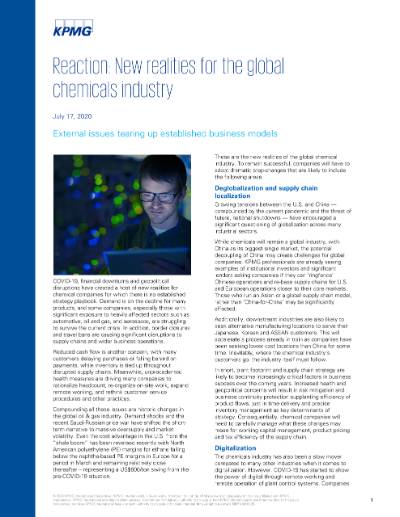COVID-19, financial downturns and geopolitical disruptions have created a host of new realities for chemical companies for which there is no established strategy playbook. Demand is on the decline for many products, and some companies, especially those with significant exposure to heavily affected sectors such as automotive, oil and gas, and aerospace, are struggling to survive the current crisis. In addition, border closures and travel bans are causing significant disruptions to supply chains and wider business operations.
Reduced cash flow is another concern, with many customers delaying purchases or falling behind on payments, while inventory is tied up throughout disrupted supply chains. Meanwhile, unprecedented health measures are driving many companies to rationalize headcount, re-organize on-site work, expand remote working, and rethink customer service procedures and other practices.
Compounding all these issues are historic changes in the global oil & gas industry. Demand shocks and the recent Saudi-Russian price war have shifted the short-term narrative to massive oversupply and market volatility. Even the cost advantage in the U.S. from the “shale boom” has been reversed recently with North American polyethylene (PE) margins for ethane falling below the naphtha-based PE margins in Europe for a period in March and remaining relatively close thereafter – representing a US$600/ton swing from the pre-COVID-19 situation.
These are the new realities of the global chemical industry. To remain successful, companies will have to adopt dramatic step-changes that are likely to include the following areas:
Deglobalization and supply chain localization
Growing tensions between the U.S. and China — compounded by the current pandemic and the threat of future, national shutdowns — have encouraged a significant questioning of globalization across many industrial sectors.
While chemicals will remain a global industry, with China as its biggest single market, the potential decoupling of China may create challenges for global companies. KPMG professionals are already seeing examples of institutional investors and significant lenders asking companies if they can ‘ringfence’ Chinese operations and re-base supply chains for U.S. and European operations closer to their core markets. Those who run an Asian or a global supply chain model, rather than ‘China-for-China’ may be significantly affected.
Additionally, downstream industries are also likely to seek alternative manufacturing locations to serve their Japanese, Korean and ASEAN customers. This will accelerate a process already in train as companies have been seeking lower cost locations than China for some time. Inevitably, where the chemical industry’s customers go, the industry itself must follow.
In short, plant footprint and supply chain strategy are likely to become increasingly critical factors in business success over the coming years. Increased health and geopolitical concerns will result in risk mitigation and business continuity protection supplanting efficiency of product flows, just in time delivery and precise inventory management as key determinants of strategy. Consequentially, chemical companies will need to carefully manage what these changes may mean for working capital management, product pricing and tax efficiency of the supply chain.
Digitalization
The chemicals industry has also been a slow mover compared to many other industries when it comes to digitalization. However, COVID-19 has started to show the power of digital through remote working and remote operation of plant control systems. Companies are now looking for new ways to drive efficiencies and we expect to see a surge in the chemicals digitization agenda, including greater adoption of artificial intelligence (AI), machine learning (ML), robotic process automation (RPA) and other technologies across the front, middle and back office. Indeed, we’re already seeing this acceleration in China as the industry recovers from the earlier shutdown.
One area with great potential is the adoption of a hybrid operating model that blends physical operations with more virtual service delivery. Properly designed and backed by more granular levels of customer data, online platforms and customer interfaces may well result in more responsive service, products better suited to customer needs, reduction of SKUs and expansion into previously overlooked or underserved markets. Balancing the advancement of technology with the more hands on levels of technical service often required by the chemical industry’s customers – particularly at the highly specialized end of the industry – will be a differentiator for those that get it right.
The workplace and workforce of the future
KPMG professionals anticipate substantial changes in structures and business processes that will likely affect how employees work, how human resources are managed, and how customers are served.
As we know, the chemicals industry has always adopted new ideas in a relatively deliberate manner with a clear focus on the impact of change on bottom line cents per pound. A large manufacturing plant is not—and should not emulate—a software startup trying to ‘move fast and break things.’ However, current conditions demand that companies accelerate their pace of change. Requirement for city center brick and mortar office space might be significantly reduced as more employees make working from home a permanent part of their job – potentially resulting in stranded assets for those with large HQ and regional centers. More fundamentally, many chemical companies are establishing zero based budgeting programs – using the current market uncertainty as a catalyst for determining what costs the organization really needs to spend.
Conversely, KPMG member firms are expecting a trend for shared service center relocation out of certain low-cost locations over the next few years. Many companies have found during the COVID-19 shutdown that not all jurisdictions have the remote technology or internet bandwidth to enable their shared service center personnel to work effectively from non-city-based office locations. Cyber security has also become a huge concern with extended working from remote locations on un-secured personal and public networks. We have seen a huge uptick in cyber-attacks from state and non-state actors since the beginning of the COVID-19 crisis – seeking to take advantage of stretched security networks and company executives with focus elsewhere. Following the de-globalization trend above, re-basing shared service locations closer to head office may provide greater continuity of service provision and de-risk cyber concerns.
Management of the employee journey is also likely to see significant change. The traditional model of leadership track employees fulfilling rotations to a number of overseas locations before returning to HQ to join the C-suite may longer be a practical model in a more remote world.
The industry also remains a laggard with respect to gender and ethnic diversity. You can count the number of female chemical company CEO's on one hand and when you look at ethnic diversity, the numbers aren't any better. Despite recent efforts, much more needs to be done to attract more women and Black, Asian and Minority Ethnic (BAME) candidates into Chemical Engineering at the graduate level – which should be easier now than ever before given the chemical industry’s role at the heart of the Environmental, Social and Governance (ESG) agenda, discussed below – and to support existing employees through their journey such that we see much greater diversity in the C-suite of chemical companies by 2030. In addition, with the massive changes to business models discussed in this paper, chemical companies may need to draw their talent from a much greater pool than ever before, perhaps competing with the technology sector to obtain digitally proficient candidates from outside the traditional pool of chemical engineers. More diverse candidates across gender, ethnicity, orientation and skills will be the path to greater profitability in the future.
Environmental, social and corporate governance
Far from distracting from the ESG agenda, there is already significant evidence that companies in chemicals – as well as upstream and downstream industries – are doubling down on ESG and embedding relevant themes at the heart of their post-COVID-19 strategy. Particular areas of focus are transitioning energy supplies to renewable sources; accessing sustainable finance to replace existing debt; and continuing to focus R&D efforts on products that support CO2 reduction and an end to plastic waste.
As those of us within the chemical industry know, the industry has been driving the sustainability agenda for many years – with chemical products saving much more CO2 further down the supply chain than is consumed in producing them. However, more needs to be done to effectively publicize these efforts and to explain the critical role the industry will play in closing the loop on the industrial supply chain – both to attract the next generation of the very best talent; and to ensure sufficient government support for the vast R&D effort that will be required to get there.
Resilience to weather the storm and emerge stronger
What we learned from the Great Financial Crisis of 2008/9 is that companies doing well before the disruption bore little relationship to how well they did afterward[1]. However, those companies that pursued both the “hunkering down” approach of cost control and placing investments in growth performed measurably better coming out of the recession than those that pursued just one of these strategies or the other.[2]
Hence, now is the time to take decisive action to improve performance. A thorough review of every revenue, cost, operational and capital lever detracting from profitability and return on capital must be interrogated and acted upon. EBITDA and economic profit level customer profitability (which includes the cost of working capital) must drive decision making and action vs. traditional material or gross margin profitability measures. These tough moves fund resiliency to manage through a longer recovery period and provide flexibility to invest in growth.
Companies that are looking to the future will also make assertive and opportunistic moves to advance on their competitors in this disruptive period. They will seek to enhance customer relationships with services, innovate with new products and technology partnerships, build new capabilities or channels to market, grow inorganically and/or adapt in ways described in this paper. These moves coupled with performance improvements should enable chemical companies to emerge stronger.
Looking ahead
Many companies have business continuity plans in place, and chemical companies have survived major storms, trade wars, political disruption, market downturns and other calamities before. But the sheer magnitude and complexity of today’s crisis demands action now to weather the storm and a whole new way of thinking about how chemical companies do business, not only for now but also for the years ahead. This crisis isn’t going to go away tomorrow, recovery will be a long and difficult road, and the very idea of business as usual will have to change. Those who build resilience with balanced cost/growth strategies now and adapt quickest to the new reality will be best placed to capitalize on the market opportunities that recovery from COVID-19 will bring.
Footnotes
1. KPMG analysis looked at total shareholder return performance for the 2006 Fortune 500 during the period of 2006-2010. Data was not available for all companies for all years.
2. Ranjay Gulati, Nitin Nohria and Franz Wohlgezogen, “Roaring out of the Recession,” Harvard Business Review, March 2010.




